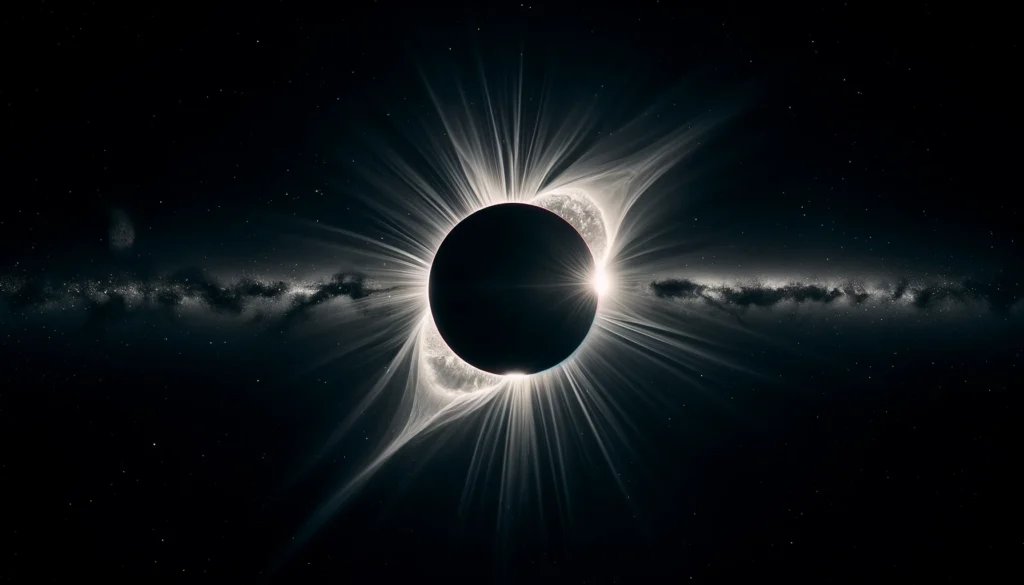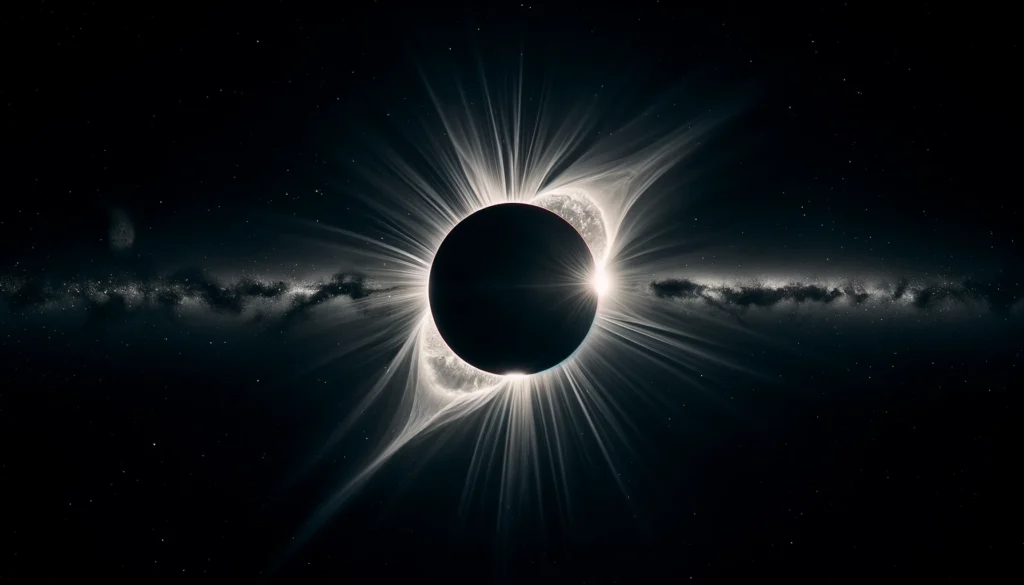

Introduction: Witnessing Nature’s Grand Spectacle
A solar eclipse is one of nature’s most awe-inspiring phenomena, offering a unique spectacle that has fascinated humans for millennia. It occurs when the Moon passes between the Earth and the Sun, casting a shadow over Earth and either partially or totally obscuring the Sun’s light in some areas. This celestial event not only captivates our imagination but also provides valuable insights into the workings of our universe. In this comprehensive guide, we’ll explore the science, history, and viewing tips for solar eclipses, ensuring you’re well-prepared for the next awe-inspiring event.
Understanding (Shadow Dance) Solar Eclipses: The Celestial Mechanics
Types of Solar Eclipses:
Solar eclipses are fascinating celestial events where the Moon obscures the Sun’s light, occurring in three main types: total, partial, and annular. Each type provides a unique visual experience based on the alignment and distances between the Sun, Moon, and Earth. During a total solar eclipse, the Moon completely covers the Sun, casting a shadow that plunges parts of Earth into daytime darkness, known as the path of totality. Observers within this path experience the rare sight of the Sun’s corona and a noticeable temperature drop, alongside the emergence of stars and planets in the daytime sky, creating a profound cosmic connection.
Partial solar eclipses occur when only part of the Sun is obscured, visible over a broader area than total eclipses but without the dramatic effects of totality. Annular eclipses, where the Moon appears smaller than the Sun due to its distant position, display a “ring of fire.” Although similar to the path of totality in total eclipses, the path of annularity during annular eclipses offers a mesmerizing view of the Sun’s bright ring around the Moon. Each eclipse type highlights the intricate dance of celestial mechanics and underscores the interconnected nature of the universe.
The Path of Totality
The path of totality in a solar eclipse represents a narrow, fleeting corridor on Earth’s surface where observers can experience the full majesty of a total solar eclipse. This remarkable phenomenon occurs when the Moon aligns perfectly between the Earth and the Sun, casting its shadow and completely obscuring the Sun’s light, enveloping the area within the path in momentary darkness. The path of totality is the only location where one can witness the complete sequence of the eclipse, from the initial partial covering of the Sun by the Moon to the awe-inspiring moments of totality, and finally, the gradual return of sunlight. This unique alignment is a rare occurrence, typically spanning a width of just about 100 miles and traversing vast distances across the globe, offering a privileged viewing experience to those within its bounds.
Witnessing an eclipse within the path of totality is often described as a transformative experience. During totality, the environment transforms into an eerie twilight, temperatures drop, and animals behave as though it is nighttime. The Sun’s corona, visible only during this phase, displays a mesmerizing halo of plasma, showcasing the Sun’s magnetic field lines and delicate structures. This spectacle, combined with the visibility of stars and planets, presents a unique celestial tableau. The beauty of the corona and the surrounding darkness create an unparalleled visual feast. Globally, the path of totality draws people from various backgrounds, uniting them in their awe of this natural event. The effort to travel and prepare for an eclipse in this path is substantial, but the payoff is a profound celestial experience that captures the grandeur of the cosmos, leaving a lasting impression on all who witness it.
Phases of a Solar Eclipse
A solar eclipse unfolds through a series of distinct phases, each contributing to the drama and anticipation of this celestial event. The first phase, known as the partial eclipse, begins when the Moon makes its initial contact with the Sun, gradually covering its disk as seen from Earth. This phase signals the onset of the eclipse, creating a growing sense of excitement as the Moon’s silhouette encroaches upon the Sun’s light. Observers equipped with solar viewing glasses or indirect viewing methods can watch as the crescent of the visible Sun wanes, a reminder of the celestial mechanics at play. As the eclipse progresses, the anticipation builds towards the climax of the event – totality.
Totality occurs when the Moon entirely obscures the Sun, casting its shadow on Earth and turning daylight into darkness within the path of totality. This remarkable phase lasts from a few seconds to over seven minutes, though typically it spans just two to three minutes. During this time, temperatures drop, stars may appear, and the Sun’s corona becomes visible, glowing dramatically against the dark sky. Observers often experience intense emotions ranging from awe to a profound sense of connection with the cosmos. After totality, the eclipse progresses to the final partial phase, where the Moon slowly reveals the Sun again. This phase is a reverse of the initial partial eclipse, leading to the end of the event. Each phase of a solar eclipse provides a distinct view of the intricate cosmic interactions between the Sun, Moon, and Earth, highlighting the mesmerizing precision of their celestial dance.
The Historical and Cultural Significance of Solar Eclipses
Eclipses in Ancient Times
In ancient civilizations, solar eclipses were seen as profound, mystical events, often interpreted as divine signs. The unexpected darkening of the sky sparked awe and fear among people without scientific knowledge of eclipses. In ancient China, it was believed that a celestial dragon was devouring the Sun, leading the emperor and his subjects to create loud noises to scare the dragon away and bring back daylight. This ritual highlights how deeply cultural mythology influenced interpretations of natural phenomena and attempts to control the uncontrollable. Ancient Greeks viewed eclipses as indicators of the gods’ anger and forthcoming disasters. Historians like Herodotus and Thucydides connected eclipses with significant historical events, considering them bad omens.
Conversely, some ancient cultures had a sophisticated grasp of eclipses, recognizing their astronomical importance and even predicting their occurrences. The Babylonians used their advanced mathematical and astronomical knowledge to predict solar eclipses using the Saros cycle, an 18-year period after which eclipses repeat. This predictive ability was a significant intellectual achievement and a tool for rulers to demonstrate control over the unpredictable. Similarly, the Maya civilization excelled in astronomy, evidenced by detailed eclipse tables in texts like the Dresden Codex, showing their capacity to predict and record eclipses with precision. These ancient insights into eclipses not only demonstrate early attempts to understand the universe but also set the stage for the development of later astronomical knowledge.
Scientific Breakthroughs
Solar eclipses have spurred significant scientific discoveries, notably during the May 29, 1919, eclipse when Sir Arthur Eddington confirmed Einstein’s General Theory of Relativity. Eddington’s observations demonstrated that massive objects like the Sun could bend light, supporting the theory that space-time is curved by gravity. This breakthrough shifted our understanding from Newton’s concept of gravity as a distant force to Einstein’s idea of space-time curvature. This pivotal experiment not only supported Einstein’s theory but also advanced theoretical physics, profoundly impacting scientific and philosophical views on the universe.
Solar eclipses have significantly advanced solar astronomy and our understanding of the Sun. For instance, during the total eclipse on August 18, 1868, astronomers Jules Janssen and Joseph Norman Lockyer discovered helium in the Sun’s atmosphere. This was the first discovery of an element outside Earth, emphasizing the value of eclipses in studying celestial phenomena. Eclipses also allow detailed studies of the Sun’s corona, leading to insights into its high temperature, structure, and the dynamics of solar phenomena, thus enhancing our knowledge of solar-terrestrial interactions and solar activity’s impact on Earth. These contributions highlight the unique scientific opportunities solar eclipses provide.
Preparing for the Next Eclipse: Viewing Tips and Safety
Viewing a solar eclipse is an exhilarating experience, but it’s crucial to do so safely. We’ll cover the essential tips and guidelines to ensure you enjoy the spectacle without risking your eyesight.
Eclipse Glasses
Eclipse glasses are essential for safely observing a solar eclipse, designed to protect eyes from harmful solar radiation. Unlike regular sunglasses, eclipse glasses are equipped with a special solar filter that blocks out 99.999% of visible light and harmful ultraviolet and infrared rays, making them indispensable during the partial phases of an eclipse when the sun is not fully obscured by the moon. The risk of “eclipse blindness” or retinal burns from viewing the sun without proper protection is significant and can lead to permanent eye damage. Therefore, it’s vital to use eclipse glasses that adhere to the international safety standard ISO 12312-2 for safe direct solar viewing. These glasses typically feature lenses made of black polymer or similar materials coated with silver or aluminum to reflect dangerous rays, ensuring viewer safety.
The distribution of eclipse glasses has become crucial during major eclipse events, accompanied by public education campaigns highlighting the importance of eye safety. Communities, schools, and astronomical societies often provide these glasses for free or at a low cost to promote safe viewing. However, the surge in demand during such events has also led to the proliferation of counterfeit glasses, which pose significant risks to consumers. It is crucial for individuals to source their glasses from reputable vendors or organizations and to check for any damage before use. Eclipse glasses should be worn throughout the partial phases, and only removed during the brief totality when the corona is visible and can be safely observed with the naked eye. The availability of eclipse glasses has made viewing both accessible and safe, serving as a reminder of the need to respect the power of the sun.
Photographing the Eclipse
Capturing the celestial spectacle of a solar eclipse through photography is an exciting challenge that combines art with science, requiring careful planning, the right equipment, and a bit of technical know-how. Unlike standard photography, photographing an eclipse necessitates special considerations due to the unique lighting conditions and the potential risk to both the photographer’s eyes and camera sensor. The primary tool required, aside from a camera, is a solar filter that fits over the lens, protecting the camera’s sensor from the intense sunlight and allowing for the direct capture of the eclipse phases without damage. This filter, similar in function to eclipse glasses for the eyes, must be removed only during the brief totality phase when the sun is completely covered by the moon, revealing the sun’s corona in all its glory.
Choosing the right camera and lens is crucial for effectively photographing a solar eclipse. Cameras with manual settings are preferred for their control over exposure and focus, essential for capturing detailed eclipse imagery. Telephoto lenses or telescopes with camera adapters help magnify distant scenes, allowing for clear images of the sun’s changing appearance. A sturdy tripod is vital for stabilizing the camera during long exposures needed to capture the corona and twilight landscape accurately. Tracking mounts are beneficial as they follow the sun’s movement, maintaining consistent focus and framing. Including an engaging foreground in the shots can enhance the narrative impact, illustrating the eclipse’s effect on the environment. Practicing with the equipment beforehand is crucial due to the brief nature of the event. Photographing a solar eclipse offers a unique blend of scientific interest and artistic expression, making it a rewarding endeavor.
Eclipse Chasing: Traveling the World for the Perfect View
For many, eclipse chasing is a passionate pursuit. We’ll explore how enthusiasts travel the globe to witness eclipses, often planning years in advance to be in the right place at the right time.
Notable Eclipses Around the World
Throughout history, numerous solar eclipses have had significant impacts, each memorable for its unique circumstances or scientific advancements. The total solar eclipse of August 11, 1999, widely observed across Europe, the Middle East, and India, darkened skies for millions and became a global spectacle. It provided the European scientific community with a rare opportunity for various experiments, enhancing understanding of the Sun’s corona and contributing valuable data for solar models. The Great American Eclipse on August 21, 2017, was another cultural phenomenon, marking the first total solar eclipse visible from the contiguous United States in nearly four decades. Stretching from Oregon to South Carolina, it captivated a vast audience and sparked nationwide interest. This event supported numerous scientific studies and served as a significant educational opportunity, with many schools and institutions organizing viewing events and programs, thus rekindling public interest in astronomy and science.
The July 2, 2019, total solar eclipse, visible across the South Pacific, Chile, and Argentina, was eagerly anticipated by scientists because it traversed regions housing some of the world’s most sophisticated astronomical observatories, including the Very Large Telescope and the Atacama Large Millimeter/submillimeter Array in northern Chile. This alignment provided astronomers with an exceptional opportunity to observe the eclipse under some of the darkest, clearest skies on Earth, allowing unprecedented views of the Sun’s corona and unique experimental opportunities available only during an eclipse. The subsequent December 14, 2020 eclipse, which similarly crossed Chile and Argentina, continued to offer spectacular views and opportunities for scientific discovery, reinforcing the role of major astronomical events in fostering international collaboration and advancing scientific knowledge. These eclipses not only enhance our understanding of the cosmos but also unite global communities through the profound impact of witnessing such spectacular celestial phenomena.
Planning Your Eclipse Trip
Traveling to witness a solar eclipse is an exhilarating adventure that requires meticulous planning and preparation to ensure a rewarding experience. The first step involves identifying the date and path of totality of the next solar eclipse, which the one can find astronomical websites or through eclipse tracking apps. Once you’ve chosen your target eclipse, researching the best viewing locations within the path of totality is crucial. Factors to consider include the weather prospects, as clear skies are essential for a successful viewing experience, and the accessibility and infrastructure of the chosen location, particularly for popular or remote areas where accommodations can fill up quickly. It’s advisable to book your travel and lodging well in advance, as eclipse events attract enthusiasts from around the globe, significantly increasing demand in the areas along the path of totality.
To enjoy a safe and fulfilling eclipse viewing experience, it’s crucial to prepare thoroughly. Essential gear includes ISO-certified solar viewing glasses to shield your eyes from harmful solar radiation. For those interested in capturing the event, investing in appropriate solar filters for cameras or telescopes is necessary. Understanding the eclipse phases and their timings at your location will enhance the experience by letting you anticipate the dramatic changes during the event. Additionally, participating in local eclipse events or groups can provide guided experiences and deepen your appreciation of the eclipse’s astronomical and cultural significance. It’s also vital to remain flexible with your plans, as local weather conditions may require last-minute changes to your viewing location. Planning an eclipse trip offers more than just witnessing celestial alignment; it’s an opportunity to delve into the cosmos’s beauty and mystery, connect with fellow astronomy enthusiasts, and create lasting memories.
The Science Behind Eclipses: Unveiling Solar Mysteries
Solar Research During Eclipses
Solar eclipses provide a rare opportunity to study the Sun’s corona, the outer atmosphere normally hidden by the solar disk’s brightness. Historically, eclipses have facilitated major discoveries in solar physics. For example, the 1919 total solar eclipse confirmed Einstein’s theory of General Relativity by demonstrating the gravitational bending of starlight by the Sun, a pivotal moment in astrophysics. Eclipses also allow detailed studies of the corona’s properties, such as temperature, density, and magnetic structure, enhancing our understanding of solar flares and coronal mass ejections. These phenomena affect space weather and have practical implications for satellite communications and Earth’s power grids. The integration of modern technology and space-based observatories during eclipses has significantly broadened the scope of solar research, enabling scientists to collect more comprehensive data and explore the Sun’s mysteries more deeply.
The study of solar eclipses has advanced heliophysics, a science focused on the Sun and its interactions with Earth and the solar system. Researchers use telescopes and observatories during eclipses to obtain high-resolution images and spectra of the Sun’s corona, enhancing our understanding of its structure and the processes heating it to temperatures far exceeding the Sun’s surface. These observations have also helped discover the Sun’s outer atmosphere and solar wind, crucial for predicting space weather events that can disrupt Earth’s communications and power systems. Each eclipse offers new insights and prompts further questions about the dynamic Sun, motivating scientists to travel globally to capture these moments of totality.
The Impact of Eclipses on Earth
Solar eclipses, beyond their scientific significance and breathtaking beauty, exert subtle yet observable effects on the environment. During a total solar eclipse, as the Moon’s shadow sweeps across the Earth, it brings about a sudden and brief twilight, causing noticeable drops in temperature and changes in wind patterns in the path of totality. This ephemeral shift in natural lighting conditions can have intriguing effects on wildlife behavior. Birds, for example, may become silent, mistaking the eclipse’s darkness for twilight and preparing to roost. Nocturnal animals, on the other hand, might be tricked into thinking night has fallen, becoming more active. These behavioral changes offer biologists a unique opportunity to study animal responses to abrupt changes in their environment, contributing to our understanding of circadian rhythms and adaptive behaviors.
The impact of solar eclipses extends to human culture and society, historically invoking awe and fear, but also fostering communal experiences and scientific curiosity. In contemporary times, eclipses have become major events that draw crowds from around the world, leading to significant temporary increases in tourism for regions in the path of totality. This influx of eclipse chasers can boost local economies but also presents challenges in terms of crowd management and environmental impact. Moreover, eclipses continue to inspire educational and outreach activities, providing a platform for public engagement with science. Schools and communities organize viewing events, while scientists and educators seize the moment to teach concepts of astronomy and the importance of scientific inquiry. The cultural and societal responses to eclipses underscore their role as phenomena that not only provoke scientific exploration but also connect people across the globe through a shared experience of the wonders of the universe.
Eclipses in Popular Culture: From Mythology to Modern Day
The dramatic nature of solar eclipses has cemented their place in popular culture, inspiring art, literature, and film.
Eclipses in Literature and Film
Solar eclipses have long fascinated literature and film, often symbolizing change, mystery, and foreboding. In literature, they mark crucial moments and symbolize characters’ internal transformations or serve as omens for significant events. For instance, in Shakespeare’s “King Lear,” an eclipse foretells the ensuing chaos and mirrors Lear’s descent into madness, linking celestial phenomena with human affairs. Similarly, in Mark Twain’s “A Connecticut Yankee in King Arthur’s Court,” an eclipse is used by the protagonist to demonstrate his supposed magical powers, altering the story’s direction and the characters’ fates. This use highlights the interplay between knowledge and superstition, a theme that resonates across cultures and epochs.
In film, eclipses often symbolize change, transition, or the unknown, profoundly influencing narratives and characters’ destinies. For example, in “Ladyhawke,” an eclipse crucially breaks a curse, symbolizing love’s triumph over adversity and enhancing the scene’s emotional impact. Similarly, in “Apocalypto,” directed by Mel Gibson, an eclipse marks a dramatic turning point, altering the protagonist’s fate and shifting the story’s momentum. These cinematic uses of eclipses not only deepen the storytelling but also showcase the enduring fascination with this celestial phenomenon and its power to evoke diverse emotions and interpretations.
Myths and Superstitions
Solar eclipses have been shrouded in myths and superstitions throughout human history, reflecting the awe and fear these celestial events inspire across different cultures. In ancient times, people see eclipses as divine messages or omens, interpreted as signs of impending doom or significant change. For example, in many ancient cultures, people thought that mythical creatures devouring the sun cause the solar eclipses. In Viking lore, the wolf Skoll was said to chase the sun, seeking to devour it, and eclipses were believed to occur when Skoll succeeded in his pursuit. This myth not only explains the phenomenon in a way that resonated with the Norse understanding of the world but also reflects the universal human impulse to comprehend and ascribe meaning to celestial events.
Solar eclipses are surrounded by numerous myths and superstitions, particularly concerning their impact on human health and affairs. Some cultures advise pregnant women to stay indoors during an eclipse to shield their unborn children from harmful forces believed to be active at these times. In parts of India, people abstain from eating during an eclipse, fearing that food becomes tainted by negative energies. These beliefs, though unscientific, underscore the significant influence of solar eclipses on the human psyche and demonstrate how different communities attempt to safeguard themselves from perceived dangers. The array of myths and superstitions linked to solar eclipses enhances their mystique and provides a window into the diverse fears, hopes, and imaginative capabilities of humans through the ages.
Frequently Asked Questions About Solar Eclipses
What is a solar eclipse?
A solar eclipse occurs when the Moon passes between the Earth and the Sun, blocking all or part of the Sun’s light.
What are the types of solar eclipses?
There are three main types of solar eclipses: total, partial, and annular. In a total eclipse, the Moon completely obscured Sun is , while a partial eclipse covers only part of the Sun. An annular eclipse features the Moon covering the Sun’s center, leaving a visible outer ring, known as a “ring of fire.”
How often do solar eclipses happen?
Solar eclipses occur 2 to 5 times per year. Total solar eclipses are less frequent, happening roughly every 18 months somewhere on Earth.
Are solar eclipses predictable?
Yes, the occurrence of solar eclipses can be precisely predicted decades in advance.
Is it safe to look at a solar eclipse?
Viewing the Sun during a solar eclipse without proper protection can damage the eyes. Special-purpose solar filters, such as eclipse glasses, are necessary for safe viewing.
How can I safely view a solar eclipse?
Eclipse glasses, solar viewers, or indirect viewing methods like a pinhole projector should be used to safely observe a solar eclipse.
Where can I see the next solar eclipse?
The visibility of a solar eclipse depends on your geographical location. Astronomical websites provide visibility maps for upcoming eclipses.
What is the path of totality?
The path of totality is a narrow area where a total solar eclipse is visible. Outside this path, only a partial eclipse can be observed.
Can solar eclipses affect animals or the environment?
Total solar eclipses can cause noticeable temperature drops and may affect animal behavior, as animals might behave as if it is nighttime.
How long does a solar eclipse last?
The length of a solar eclipse varies; a total solar eclipse can last up to 7.5 minutes, although most are shorter. The partial phases can last over an hour.
Conclusion: The Enduring Fascination with Solar Eclipses
In closing, we reflect on the enduring allure of solar eclipses, a testament to the human spirit’s unquenchable thirst for knowledge and the beauty of the universe. As we await the next celestial spectacle, the cosmos is keeping reminding us of our place in it and the shared experiences that connect us all.
Appendix: Resources and Further Reading
For those eager to dive deeper into the subject, this section will provide a curated list of resources, including websites, books, and documentaries on solar eclipses




2 thoughts on “Solar Eclipses: All what you need to know”